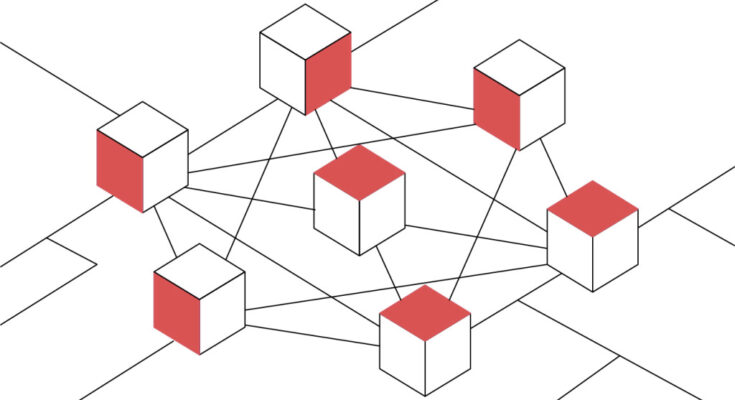Explore the intricate journey of blockchain interoperability, this article unravels the complexities surrounding the seamless collaboration of disparate networks. From defining the significance of interoperability in the decentralized landscape to exploring innovative solutions like Hashed Time-Locked Contracts (HTLCs) and Atomic Swaps, we delve into the challenges, real-world applications, and the future landscape. Let’s dive deep and study the role of interconnected blockchains in shaping the future of decentralized technologies.
What is Blockchain Interoperability?
Blockchain interoperability is a revolutionary concept that addresses the need for seamless communication and collaboration between different blockchain networks. It involves creating protocols and standards that enable the exchange of data, assets, and information across disparate blockchains. This interoperability is crucial for fostering a more connected and efficient decentralized ecosystem.
The Current State of Blockchain Networks
Major blockchain platforms like Ethereum, Bitcoin, and Binance Smart Chain dominate the landscape. Each platform has unique features, use cases, and strengths. However, the lack of a standardized framework for communication and collaboration inhibits their seamless integration.
Siloed blockchains face inherent challenges, including limited data exchange, inefficient asset transfers, and difficulties in executing cross-platform smart contracts. This section explores the constraints imposed by operating in isolation, emphasizing the need for interoperability to overcome these challenges.
The absence of standardized protocols for interconnectivity and collaboration among blockchain networks hampers the growth of the decentralized ecosystem. This subsection delves into how the current lack of interoperability limits the potential for collaborative projects and inhibits the emergence of a more interconnected blockchain environment.
Why Interoperability Matters?
Blockchain interoperability streamlines the process of transferring assets between different blockchains. It enables users to move tokens or assets seamlessly, unlocking liquidity and expanding the scope of decentralized applications (DApps) and services.
Smart contracts are a cornerstone of blockchain functionality. Interoperability allows these contracts to operate seamlessly across different blockchains, fostering innovation and enabling developers to create decentralized applications that leverage the unique features of multiple platforms.
The scalability of blockchain networks is a persistent challenge. Interoperability addresses this issue by distributing transactions and computational load across multiple blockchains. This not only enhances the performance of individual networks but also contributes to the overall scalability of the decentralized ecosystem.
Types of Blockchain Interoperability
Cross-Chain Communication Protocols
Cross-chain communication protocols bridge different blockchain networks, enabling the exchange of information and assets. Examples include Polkadot’s XCMP and Cosmos’ Inter-Blockchain Communication (IBC) protocol.
Sidechains and Pegged Assets
Sidechains are parallel chains connected to a primary blockchain, allowing assets to move between them. Pegged assets represent assets from one blockchain on another, facilitating the transfer of value and data between disparate blockchain networks.
Interoperability Standards and Initiatives
Developing and adopting interoperability standards is crucial for creating a unified blockchain ecosystem. Initiatives such as the W3C Blockchain Interoperability Standards, Interledger Protocol (ILP), and standards promoted by the Enterprise Ethereum Alliance (EEA) contribute to establishing a more interoperable and standardized blockchain landscape.
Technological Approaches to Achieving Interoperability
Hashed Time-Locked Contracts (HTLCs)
HTLCs are cryptographic contracts that enable secure and trustless transactions between parties on different blockchains. This technology ensures that the conditions of a transaction are met within a specified timeframe, allowing for the seamless transfer of assets between blockchains.
Atomic Swaps
Atomic swaps enable the direct exchange of cryptocurrencies across different blockchains. These swaps occur atomically, meaning that either the entire transaction is completed, or none of it happens. Atomic swaps eliminate the need for intermediaries, providing a decentralized and secure method for users to exchange assets across disparate blockchain networks.
Middleware and Interoperability Layers
Middleware and interoperability layers act as intermediaries facilitating communication and data exchange between blockchains. These layers operate between the core protocols of blockchain networks, providing a bridge for seamless interoperability.
Challenges in Achieving Blockchain Interoperability
Interoperability introduces new challenges in terms of security. Ensuring the integrity and confidentiality of transactions across interconnected blockchains is paramount. This subsection explores the security considerations that must be addressed to maintain the trustworthiness of interoperable blockchain networks.
Different blockchains often operate on distinct consensus mechanisms, introducing challenges in achieving alignment. This part examines how consensus mechanism misalignment can hinder interoperability and explores potential solutions to this challenge.
Regulatory and compliance considerations pose significant hurdles to achieving blockchain interoperability. This subsection explores the complexities associated with regulatory frameworks and compliance requirements across different jurisdictions and how they impact interoperability initiatives.
Prominent Projects and Initiatives in Blockchain Interoperability
Polkadot: A Multi-Chain Network
Polkadot is a prominent project that aims to create a multi-chain network, allowing different blockchains to interoperate seamlessly. This subsection explores the key features of Polkadot and its role in promoting a more interconnected blockchain ecosystem.
Cosmos: The Internet of Blockchains
Cosmos operates as the “Internet of Blockchains,” providing an ecosystem where different blockchains can communicate and transact. This part delves into the Cosmos project, highlighting its vision and contributions to blockchain interoperability.
Ripple: Connecting Financial Institutions
Ripple focuses on facilitating cross-border payments by connecting financial institutions. This subsection explores how Ripple’s technology contributes to achieving interoperability within the financial sector.
Hyperledger: Enterprise-Grade Interoperability
Hyperledger is an open-source collaborative effort that aims to advance cross-industry blockchain technologies. This part examines how Hyperledger fosters enterprise-grade interoperability through its various projects and initiatives.
The Role of Standards in Fostering Interoperability
- The World Wide Web Consortium (W3C) plays a crucial role in developing standards for blockchain interoperability. This subsection outlines the efforts of W3C in establishing protocols that enhance the interoperability of blockchain networks.
- The Interledger Protocol (ILP) is designed to facilitate payments across different payment networks. This part explores how ILP contributes to achieving interoperability by providing a common protocol for secure and efficient value transfer.
- The Enterprise Ethereum Alliance (EEA) focuses on developing standards for enterprise blockchain applications. This subsection discusses the role of EEA in fostering interoperability among Ethereum-based projects and beyond.
Real-World Use Cases of Blockchain Interoperability
Cross-Border Payments
Blockchain interoperability streamlines cross-border payments by enabling secure and transparent transactions across different financial networks. This part explores how interoperability is transforming the traditional cross-border payment landscape.
Supply Chain Management
Interoperability enhances supply chain management by facilitating seamless data exchange and traceability across multiple blockchain networks. This subsection delves into how interoperability improves transparency and efficiency in supply chain operations.
Decentralized Finance (DeFi) Ecosystem
The decentralized finance (DeFi) ecosystem leverages blockchain interoperability to create a more inclusive and interconnected financial landscape. This part examines how interoperability contributes to the growth and innovation within the DeFi space.
The Future Landscape of Interoperable Blockchains
Technological advancements continue to shape the future of blockchain interoperability. This subsection explores emerging solutions and innovations that are likely to play a pivotal role in enhancing the connectivity and functionality of interoperable blockchains.
Regulatory clarity and global collaboration are critical factors influencing the future of blockchain interoperability. This part discusses how evolving regulatory frameworks and increased collaboration among stakeholders contribute to the maturation of interoperable blockchains.
Interoperable blockchains have the potential to reshape industries and drive innovation. This subsection explores the anticipated impact on various sectors, highlighting how interconnected blockchain networks can foster new business models and transformative technologies.
Challenges and Considerations for Stakeholders
Developers and protocol designers face the challenge of creating interoperable solutions that are secure, scalable, and aligned with industry standards. This part explores the considerations and best practices for those actively shaping the technological aspects of interoperable blockchains.
Businesses and enterprises seeking to leverage blockchain interoperability must navigate considerations related to data privacy, integration costs, and regulatory compliance. This subsection examines how businesses can strategically approach and benefit from interoperable blockchain solutions.
Regulatory bodies and policymakers play a crucial role in establishing a conducive environment for blockchain interoperability. This part explores the challenges regulators face in adapting to this rapidly evolving landscape and the considerations needed to strike a balance between innovation and regulation.
Conclusion
The conclusion revisits the fundamental importance of blockchain interoperability in realizing the full potential of decentralized technologies. It underscores how interoperability fosters collaboration, innovation, and a more efficient decentralized ecosystem.
Highlighting the journey from isolated blockchain networks to interconnected ecosystems, this subsection reflects on the evolution of blockchain networks. It acknowledges the challenges overcome and the milestones achieved in the pursuit of seamless interoperability.
The conclusion concludes by emphasizing the role of interconnected blockchains in shaping the future of decentralized technologies. It envisions a connected blockchain ecosystem that transcends the limitations of isolation, fostering a new era of collaboration, transparency, and transformative innovation.




